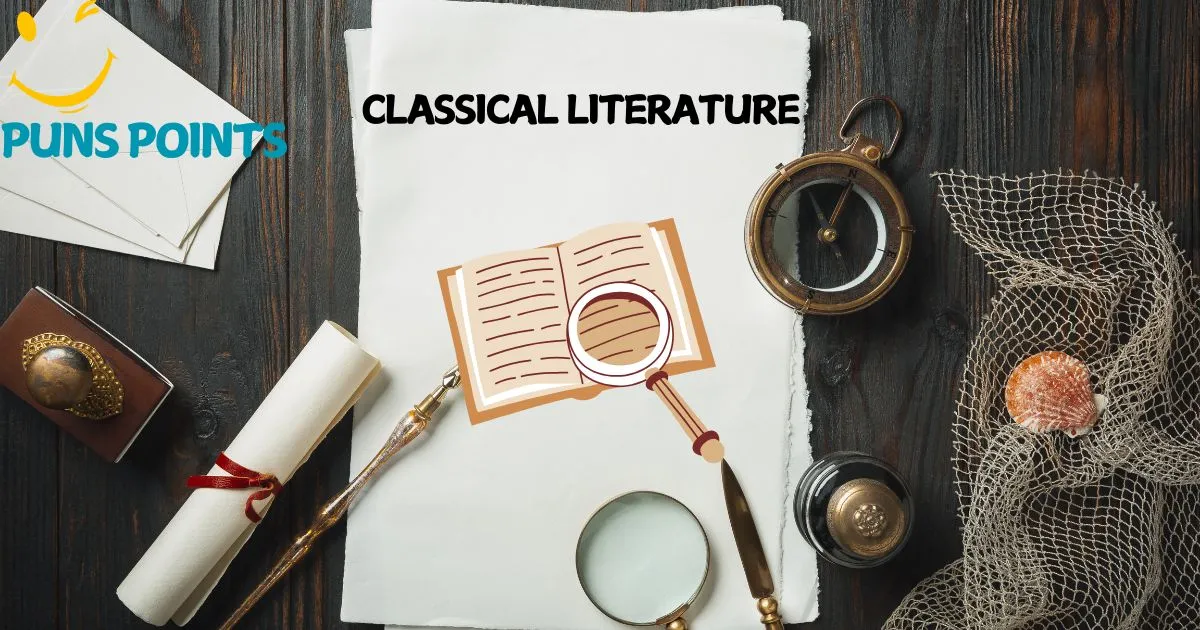“Classical literature is rich with puns, where wit and humor combine to create timeless moments of brilliance.”
Classical literature has long been a source of inspiration and fascination, offering insights into human nature, society, and the world around us. One of the most delightful elements of these works is the clever use of puns.
Puns, often seen as a form of wordplay, have been used by many famous writers to add humor, complexity, and layers of meaning to their works. From Shakespeare to Dickens, classical literature is filled with brilliant examples of how puns can engage the reader and enhance the storytelling experience.
As we dive into the world of classical literature, it’s essential to appreciate the wit and skill behind these puns. Writers like Shakespeare, Dickens, and others used puns not only to entertain but also to deliver social commentary, explore themes of identity, and offer a playful critique of the human condition.
IF you’re a long-time lover of literature or a newcomer to these works, understanding the role of puns will deepen your appreciation of the classics.
In this post, we’ll explore the fascinating world of classical literature and examine how puns have played an essential role in shaping literary works. We’ll look at specific examples from Shakespeare, the 18th century, and Dickens, and see how these puns add layers of meaning, humor, and insight to the texts. Let’s discover the power of wordplay and how it has endured through the ages.
Shakespeare’s Witty Wordplay The Bard’s Favorite Pun-ishment
- Shakespeare’s wit was unmatched in his use of wordplay.
- Puns in his plays were often layered with multiple meanings.
- Mercutio’s puns in Romeo and Juliet remain iconic.
- The word “grave” in Hamlet plays with the double meaning of seriousness and burial.
- Shakespeare’s use of puns was often a reflection of social commentary.
- His puns often challenge the audience’s perception of reality.
- In Twelfth Night, the character Feste’s puns are an essential part of the humor.
- Shakespeare’s characters sometimes used puns to show wit, often revealing hidden meanings.
- A Midsummer Night’s Dream features puns that play on words of magic and transformation.
- Puns in Shakespeare’s sonnets reveal deeper emotional layers beneath the surface.
- The pun on “nothing” in Much Ado About Nothing is a clever commentary on love.
- His wordplay helps define character relationships and dynamics.
- Shakespeare used puns to mock authority figures, especially in his comedies.
- A quick wit was a sign of intelligence in Shakespeare’s plays.
- His puns were often self-aware, acknowledging the absurdity of language.
- The use of puns in his tragedies emphasizes the tension between fate and free will.
- Gender roles and identity were often explored through puns in his works.
- The puns in The Tempest convey a sense of magical realism.
- Shakespeare’s puns often remain timeless, still engaging audiences today.
- Language, for Shakespeare, was a vehicle for both humor and tragedy.
The Puns of the Restoration: Wordplay at Its Prime
- Restoration writers were masters of wit and wordplay.
- The comedy of manners genre heavily relied on puns for humor.
- John Dryden frequently used puns to satirize society.
- In The Way of the World, puns reveal the duplicity of characters.
- William Congreve’s puns in The Way of the World show his sharp commentary on love and deception.
- Restoration playwrights used puns to explore social roles and class dynamics.
- Puns were used to poke fun at court life during the Restoration period.
- The witty repartee in Restoration comedies was often built on puns.
- Richard Steele and Joseph Addison incorporated puns in The Spectator.
- Satirical puns were a tool for criticizing political and religious issues.
- Restoration puns often highlighted the contrast between appearance and reality.
- Love and marriage were frequently explored through playful wordplay.
- Characters in Restoration comedies often used puns to manipulate situations to their advantage.
- The use of puns was central to the fast-paced dialogue of Restoration plays.
- Sexual innuendo through puns became a hallmark of Restoration humor.
- Restoration writers often blurred the line between high and low culture through puns.
- The verbal dexterity of Restoration playwrights added an extra layer to their plays.
- Puns served to engage audiences intellectually, requiring them to think critically.
- The influence of French theater brought new puns to English drama.
- The use of puns in Restoration contributed to a more free-thinking, secular society.
Penguin Puns That’ll Have You Waddling with Laughter [2025]
Dickens and the Art of Subtle Wordplay
- Charles Dickens was known for his clever, subtle use of puns.
- Puns in Dickens’ novels reveal his mastery of the English language.
- David Copperfield features subtle puns that add depth to its characters.
- The names of characters in Bleak House often contain puns that highlight their personalities.
- Dickens’ humor often uses puns to critique social structures and class disparity.
- The character Mr. Micawber in David Copperfield has a name that suggests both optimism and financial misfortune.
- Puns in Oliver Twist create humor while exploring themes of poverty and exploitation.
- Dickens’ satirical style was enhanced by the use of wordplay.
- His use of puns makes his characters memorable and layered with meaning.
- In A Tale of Two Cities, the character of Sydney Carton is imbued with wordplay that signals his transformation.
- The names in Hard Times often carry hidden meanings, thanks to Dickens’ wordplay.
- Dickens was a master at using puns to highlight the absurdity of certain social conventions.
- The dialogue in Great Expectations is rich with puns, especially in scenes with Pip and Estella.
- Dickens used puns to reveal characters’ internal contradictions.
- Dark humor in Dickens’ works often stems from his use of wordplay to create irony.
- Dickens’ puns add a layer of irony to his portrayals of Victorian society.
- Puns in Dickens’ works are often woven into the plot, making them central to the action.
- The use of puns creates a sense of realism in Dickens’ vibrant, larger-than-life characters.
- Dickens’ puns were often mordantly clever, reflecting the darker side of his humor.
- The subtlety of Dickens’ wordplay shows his great skill in shaping both narrative and character.
The Legacy of Puns in Literature: A Timeless Tradition
- Puns have been a core element of literature for centuries.
- Writers use puns to highlight complex themes and ideas.
- The power of puns lies in their ability to entertain while provoking thought.
- Pun usage in literature transcends time, from ancient texts to modern novels.
- The enduring legacy of puns lies in their ability to engage readers with multiple interpretations.
- Wordplay often reflects the cultural context of the time it was written.
- Puns can make the serious lighter by providing a humorous twist on a subject.
- Through puns, writers often bring out the irony in life’s situations.
- Modern authors continue the tradition of using puns to add depth and humor to their stories.
- Puns are key in building a playful relationship between author and reader.
- Shakespeare’s influence continues in the use of puns by contemporary writers.
- Puns have been employed to challenge and subvert societal norms.
- Puns in classic literature often carry a moral message wrapped in humor.
- Modern literature has reinterpreted puns, integrating them into contemporary language.
- Puns enrich character development, offering insight into a character’s intelligence or personality.
- Through punning, writers can shape dialogue to express complex emotions.
- Political satire often uses puns to address societal issues with humor and criticism.
- Puns make a text memorable, adding layers of meaning that linger after reading.
- The rhythm and sound of puns can add musicality to the language of literature.
- Puns will likely continue to be a playful and insightful tool for writers in the future.
Conclusion
Puns have been a cherished literary device throughout history, from the clever wordplay of Shakespeare to the subtle wit in Dickens’ works. They are more than just a form of humor—they serve as tools for deeper social commentary, character development, and exploration of complex themes.
When in the timeless classics of the Restoration or the engaging narratives of Victorian literature, puns have a way of making serious subjects approachable while adding layers of meaning. The legacy of puns continues to thrive in literature today, enriching both classical and contemporary works.
Through their clever twists and turns, puns keep readers engaged, provoke thought, and showcase the brilliance of language.
Key Insight
1. Why are puns important in literature? Puns add humor and depth to literary works, allowing authors to communicate multiple meanings in a single word or phrase. They also make texts more engaging by offering witty and clever insights.
2. How do puns contribute to character development? Puns help define a character’s intelligence, social status, and even moral compass. They can highlight personality traits, like wit or sarcasm, and show how characters interact with the world around them.
3. Are puns only used in comedies? No, puns appear in all genres, including tragedies and historical fiction. They can lighten the mood in serious works or underscore a moment of irony or conflict.
4. Can puns change the meaning of a story? Yes, puns can shift the tone or meaning of a story by adding layers of interpretation. They can convey hidden truths, reveal a character’s motivations, or introduce new perspectives on themes.
5. Why do writers use puns across different eras? Puns are a timeless form of wordplay that transcend cultural and historical contexts. Writers from Shakespeare to modern authors use puns because they are an effective and entertaining way to engage readers, convey complexity, and enhance their storytelling.

Hi! I’m Jane Austen, a master of timeless puns with a modern twist, blending wit and laughter into every line!

